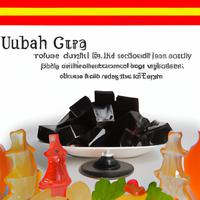
1 serving (30 grams) contains 103 calories, 2.1 grams of protein, 0.1 grams of fat, and 23.2 grams of carbohydrates.

Log this food in SnapCalorie

Nutrition Information
Calories |
823.2 | ||
|---|---|---|---|
% Daily Value* |
|||
| Total Fat | 0.5 g | 0% | |
| Saturated Fat | 0 g | 0% | |
| Polyunsaturated Fat | 0 g | ||
| Cholesterol | 0 mg | 0% | |
| Sodium | 120 mg | 5% | |
| Total Carbohydrates | 185.8 g | 67% | |
| Dietary Fiber | 0 g | 0% | |
| Sugars | 112.6 g | ||
| protein | 16.6 g | 33% | |
| Vitamin D | 0 mcg | 0% | |
| Calcium | 16.8 mg | 1% | |
| Iron | 0.7 mg | 3% | |
| Potassium | 50.4 mg | 1% | |
* Percent Daily Values are based on a 2,000 calorie diet. Your daily values may be higher or lower depending on your calorie needs.
Food Attributes
Source of Calories
About Haribo gumeni
Haribo Gummi candies, originating from Germany, are a popular confectionery known for their chewy texture and fruity flavors. Composed primarily of glucose syrup, sugar, gelatin, citric acid, and natural or artificial flavorings, these colorful treats come in various shapes and designs, with the iconic gummy bear as their signature product. While low in fat, Haribo Gummis are high in sugar and carbohydrates, making them a quick energy boost but not particularly nutrient-dense. They are free of cholesterol and, in some variations, may include natural fruit juice or colorings. However, their gelatin content makes them unsuitable for vegetarian and vegan diets, and their high sugar content means they should be enjoyed in moderation. Often used as a fun indulgence or celebratory snack, Haribo Gummi candies reflect playful European confectionery traditions but are best treated as an occasional treat rather than a health food.



